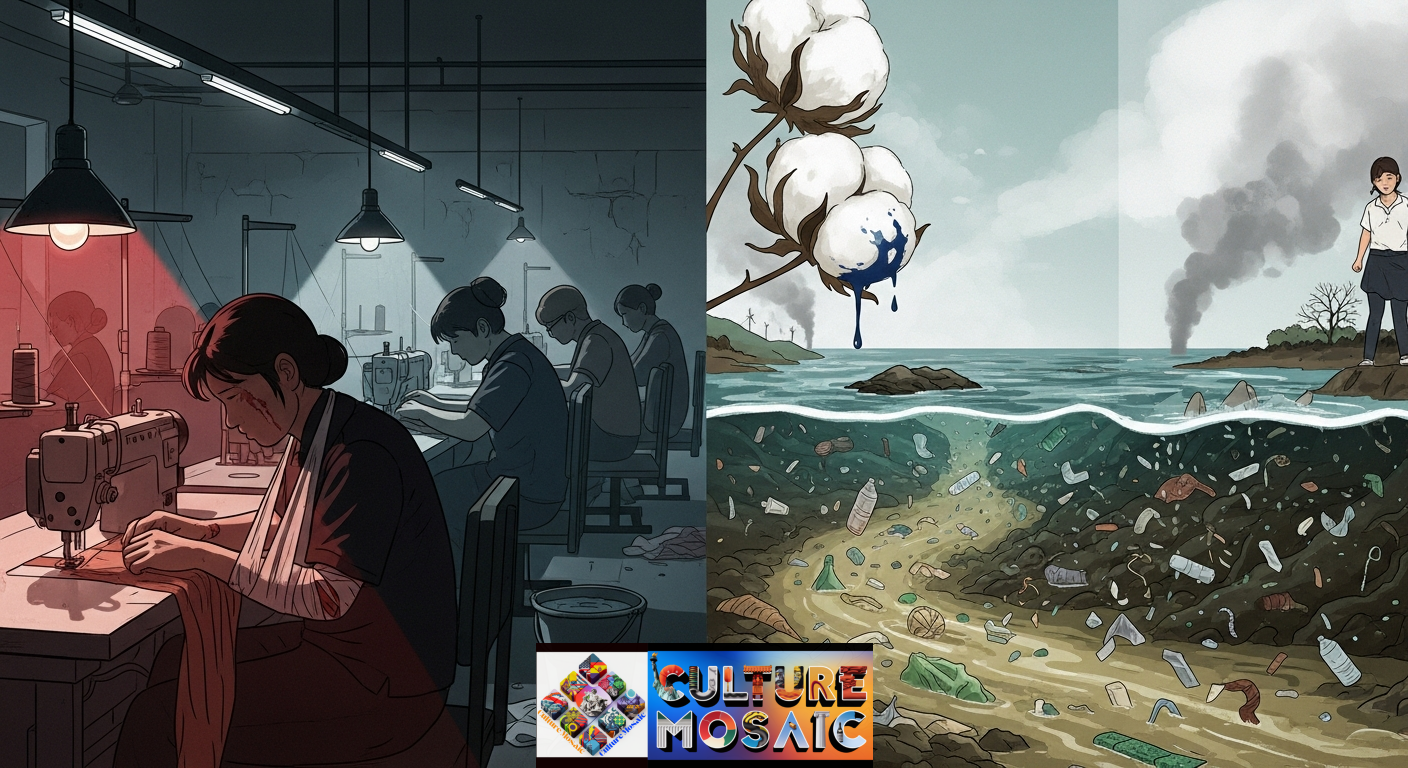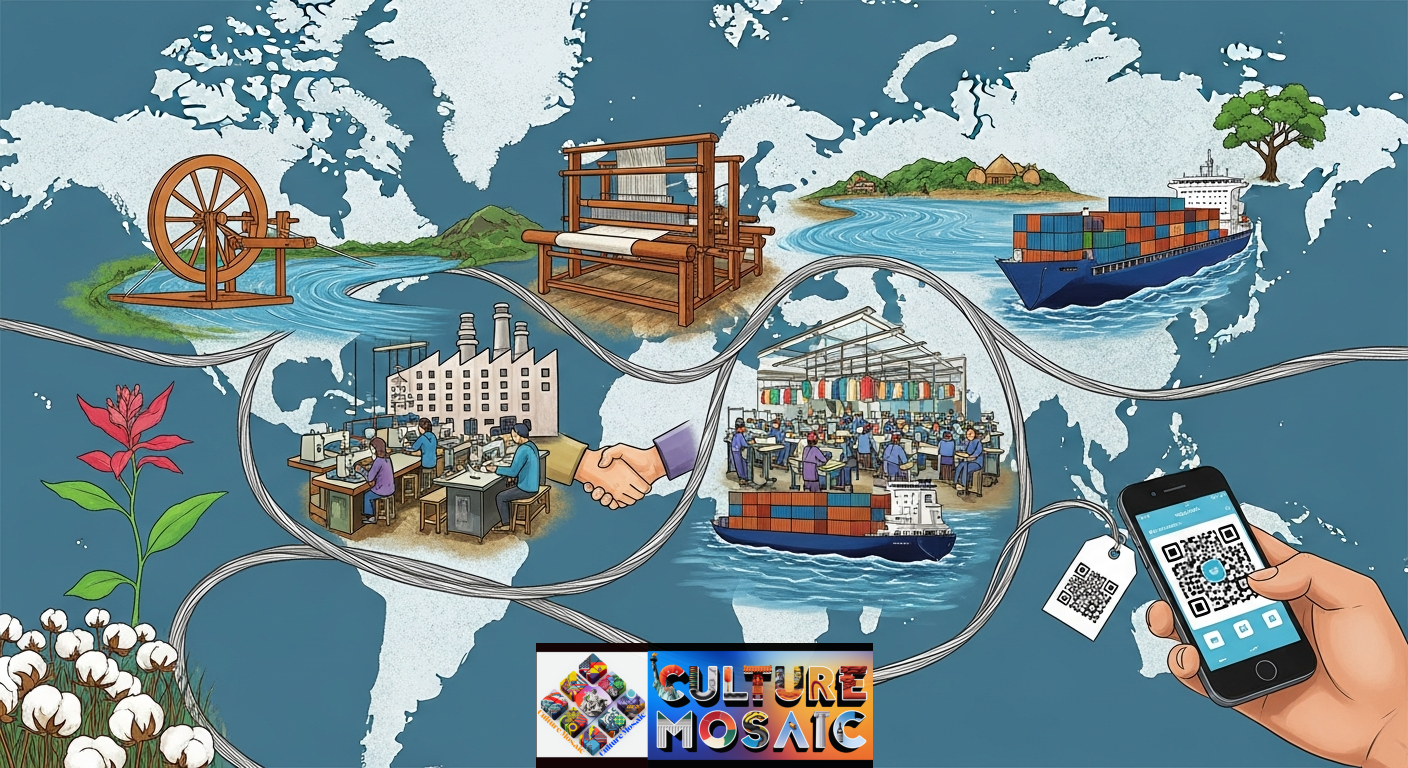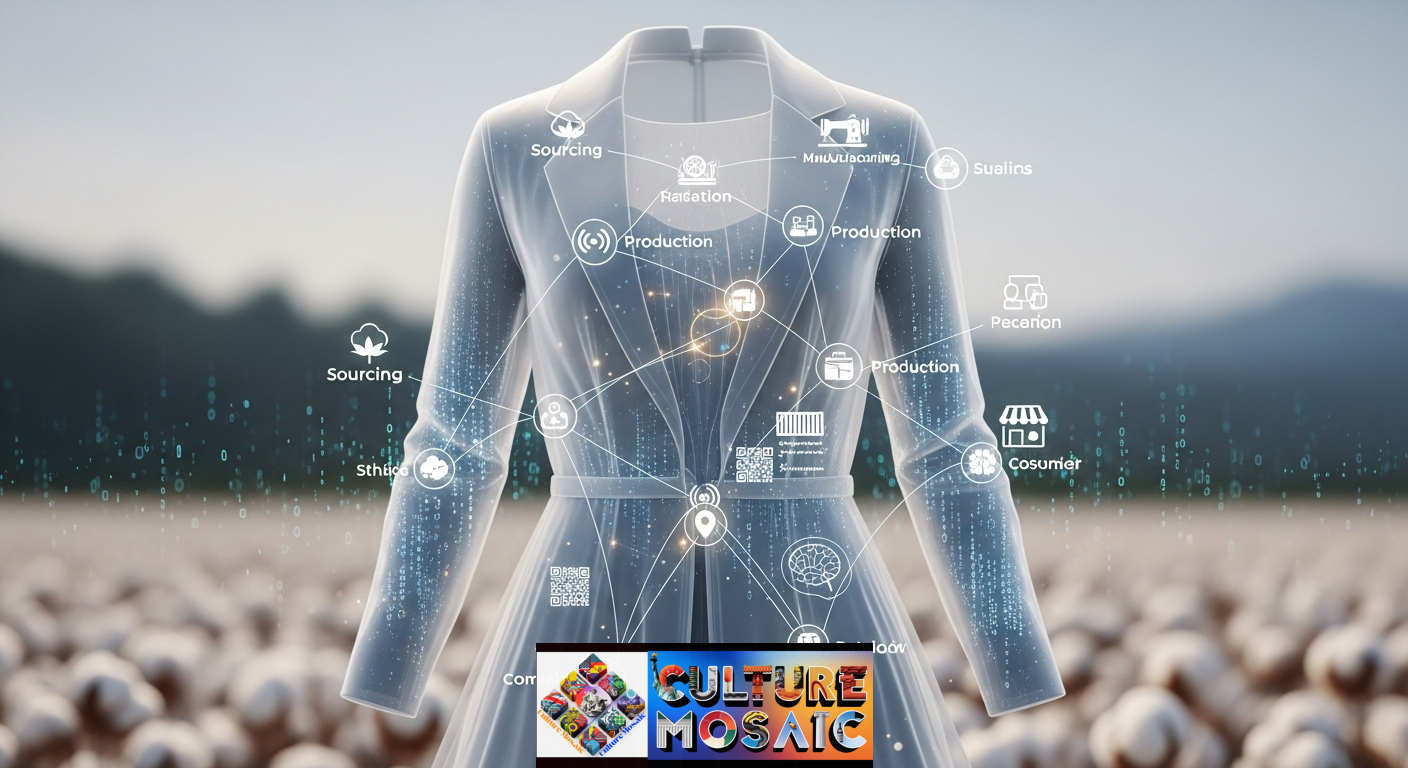Every piece of clothing tells a story. The problem is, most of us have no idea what that story actually is.
The Ethical Fashion Supply Chain: When you pick up a shirt at your favorite store, you’re holding the result of a journey that spans continents, involves dozens of people, and leaves a trail of environmental and social impact. The ethical fashion supply chain is about making that journey visible and ensuring everyone involved is treated fairly along the way.
Americans buy roughly 68 garments per year, yet less than 1% of clothing material is recycled into new clothing. Behind those statistics are real people working in factories, communities affected by textile waste, and an industry that’s reckoning with its responsibility. Understanding the ethical fashion supply chain isn’t just about feeling good about your purchases. It’s about recognizing that your clothing connects you to a global network of workers, resources, and communities.
What Is an Ethical Fashion Supply Chain?

An ethical fashion supply chain tracks every step of a garment’s creation, from the cotton field to your closet, while ensuring fair treatment of workers and minimal environmental harm.
Think of it as the complete biography of your clothes. A traditional supply chain focuses purely on efficiency and cost. An ethical fashion supply chain adds two critical dimensions: social responsibility and environmental stewardship.
Here’s what makes a supply chain ethical:
Fair labor practices mean workers receive living wages, not just minimum wages. There’s a massive difference. A living wage covers basic needs like housing, food, healthcare, and education. Many garment workers globally earn barely enough to survive, let alone support their families.
Safe working conditions ensure factories meet basic safety standards. This became painfully clear after the 2013 Rana Plaza collapse in Bangladesh, which killed over 1,100 garment workers. Ethical fabric supply chains prioritize worker safety through regular inspections and building upgrades.
Environmental responsibility involves using sustainable materials, reducing water consumption, minimizing chemical use, and managing waste properly. The fashion industry is responsible for about 10% of global carbon emissions, more than international flights and maritime shipping combined.
Transparency means brands can tell you exactly where and how your clothing was made. No vague “Made in China” labels. Real transparency includes factory names, worker testimonials, and third-party certifications.
The Ethical Fashion Supply Chain: The Hidden Cost of Fast Fashion

Fast fashion operates on a model that’s fundamentally at odds with ethical fashion supply chains.
The business model is simple: produce trendy clothes as cheaply and quickly as possible, sell them at rock-bottom prices, and encourage consumers to treat them as disposable. Americans now throw away about 81 pounds of clothing per year. That’s roughly 11 million tons of textile waste annually in the US alone.
But the real cost isn’t measured in landfills. It’s measured in human lives.
Garment workers in countries like Bangladesh, Cambodia, and Vietnam often work 14-hour days in unsafe conditions for wages that barely cover rent and food. Factory owners face intense pressure from Western brands to cut costs and speed up production. When brands demand lower prices and faster turnarounds, workers pay the price through wage cuts, forced overtime, and compromised safety standards.
The environmental damage is equally severe. Textile dyeing ranks as the planet’s second-most significant source of water pollution. A single cotton t-shirt requires about 2,700 liters of water to produce, enough for one person to drink for 2.5 years. Synthetic materials like polyester shed microplastics with every wash, polluting oceans and entering the food chain.
The ethical fashion supply chain emerged as a direct response to these problems.
The Ethical Fashion Supply Chain: How Global Threads Connect Us All

When we talk about global threads in fashion, we’re talking about something both literal and metaphorical.
Literally, your clothing connects you to people across the world. The cotton might come from India, get spun into yarn in Turkey, woven into fabric in China, cut and sewn in Bangladesh, and shipped from Vietnam. Each step involves different workers, communities, and environmental impacts.
Metaphorically, these threads represent our interconnected responsibility. The person who sewed your jeans deserves fair treatment just as much as the person who sold them to you. The river near a textile mill in Indonesia matters just as much as the river in your hometown.
Ethical fashion supply chains make these connections visible. Instead of hiding the messy reality behind slick marketing, transparent brands acknowledge the complexity and take responsibility for every link in the chain.
This is where traceability becomes crucial. Modern ethical fashion supply chains use technology to map every step of production. Some brands now include QR codes on garment tags. Scan the code with your phone, and you can see photos of the factory, read about the workers, and verify certifications. You’re not just buying a shirt anymore. You’re supporting a specific community of craftspeople.
The most progressive brands go even further, publishing supplier lists, sharing audit results, and acknowledging problems when they find them. Transparency isn’t about claiming perfection. It’s about being honest when things go wrong and showing how you’re working to fix them.
The Technology Revolutionizing Supply Chain Transparency

Blockchain isn’t just for cryptocurrency anymore. It’s becoming the backbone of ethical fashion supply chain verification.
Here’s how it works: Every time a garment moves through the supply chain, that transaction gets recorded on a digital ledger. Who grew the cotton? Recorded. Which mill spun the yarn? Recorded. What dyes were used? Recorded. Where was it sewn, by whom, and under what conditions? All recorded.
Because blockchain records can’t be altered after the fact, they create an unchangeable history of each garment. This matters because greenwashing has become a massive problem in fashion. Brands slap “eco-friendly” labels on products without any real evidence. Blockchain-based tracking makes it much harder to fake sustainability credentials.
Several companies are already implementing this technology. Some luxury brands use blockchain to verify authenticity and ethical sourcing. Smaller ethical brands use it to differentiate themselves from competitors, making empty claims.
QR codes and digital product passports are the consumer-facing side of this technology. Instead of requiring specialized knowledge to verify ethical claims, shoppers can simply scan a code and access detailed information about their purchase. This shifts power toward consumers and creates market pressure for better practices.
RFID tags and GPS tracking help brands monitor their supply chains in real time. If a shipment suddenly reroutes through an unauthorized facility, the brand knows immediately. This prevents “fabric laundering,” where unethical materials get mixed into ethical fashion supply chains.
Artificial intelligence is being used to analyze supplier data and identify risk factors. Machine learning algorithms can spot patterns that suggest worker exploitation or environmental violations, allowing brands to investigate before problems escalate.
The technology is still evolving, and adoption isn’t universal yet. But the trend is clear: the ethical fashion supply chain of the future will be radically more transparent than anything we have today.
The Ethical Fashion Supply Chain: Living Wages and the Economics of Ethical Fashion
Here’s an uncomfortable truth: most clothing brands could afford to pay living wages without significantly raising prices.
Research shows that doubling garment worker wages in Bangladesh would increase the retail price of clothing by only about 1-2%. For a $20 shirt, that’s 20-40 cents. Most consumers say they’d willingly pay that premium for ethically sourced clothing.
So why don’t more brands do it?
The current system wasn’t designed around worker welfare. It was designed around razor-thin margins and maximum efficiency. Changing that requires restructuring relationships throughout the supply chain, and many brands fear disrupting existing systems.
Living wages vary by location because the cost of living differs globally. In Bangladesh, a living wage might be $175 per month. In Cambodia, $250. The key is that these wages cover basic needs with a little left over for emergencies and savings. Most garment workers currently earn minimum wage, which in many countries is less than half of what’s needed for basic survival.
Brands committed to ethical fashion supply chains work with factories to gradually increase wages, improve conditions, and provide benefits like healthcare and childcare. This isn’t charity. It’s good business. Workers who are paid fairly and treated well are more productive, stay with employers longer, and produce higher-quality work.
Some brands use a “cost transparency” model, breaking down exactly how much of your purchase price goes to materials, labor, transportation, and profit. When you see that only $3 of your $50 shirt went to the person who made it, it clarifies where change is needed.
Fair trade certifications help, but they’re not perfect. Look for brands that go beyond minimum certification requirements and actively publish wage information. The most ethical brands treat fair wages as a baseline, not an achievement.
The Ethical Fashion Supply Chain: How to Spot a Truly Ethical Brand
Greenwashing is everywhere. Here’s how to see through it.
Look for specific certifications. Fair Trade Certified, B Corporation, GOTS (Global Organic Textile Standard), and Bluesign are meaningful. Vague phrases like “eco-conscious” or “sustainably minded” usually mean nothing without backing documentation.
Check if they publish their supplier list. Brands with nothing to hide will tell you exactly which factories they work with. If this information isn’t readily available on their website, that’s a red flag.
Read the “About” section carefully. Ethical brands typically explain their mission in detail, with specifics about wages, working conditions, and materials. If a brand’s sustainability page is just marketing speak without concrete information, be skeptical.
Look for third-party audits and transparency reports. Annual impact reports, factory audit results, and honest acknowledgments of challenges suggest a brand is serious about ethics, not just using it as a marketing angle.
Research the materials. Organic cotton, linen, hemp, and Tencel are generally more sustainable than conventional cotton or virgin polyester. Recycled materials are good, but verify they’re actually recycled (some “recycled” products contain mostly virgin materials).
Check the price point. This is tricky because ethical fashion doesn’t have to be expensive, but it also can’t be as cheap as fast fashion. If you’re seeing prices comparable to major fast fashion chains, question how they’re achieving those costs ethically.
See if they talk about their workers. Brands truly invested in ethical supply chains feature stories from the people who make their clothes. They know their workers’ names and share their experiences.
Verify the business model. Some brands are genuinely built around ethical practices from day one. Others add ethical lines later as marketing tools while maintaining unethical practices elsewhere. Check if ethics are core to the entire business or just a side project.
Look at how they handle criticism. When labor rights organizations or journalists raise concerns, how does the brand respond? Defensive dismissal is a bad sign. Acknowledgment and commitment to improvement are better.
Trust your instincts. If something seems too good to be true (ultra-cheap prices with claims of perfect ethics), it probably is.
The Role of Consumers in Ethical Fashion Supply Chains
Individual choices matter, but systemic change requires collective action.
Buying from ethical brands sends a market signal that consumers care about how clothes are made. Every purchase is a vote for the kind of industry you want to support. But individual shopping decisions alone won’t transform the fashion industry.
Real change requires:
Political advocacy. Support legislation that requires supply chain transparency and holds brands accountable for labor violations. The California Transparency in Supply Chains Act and similar laws create legal frameworks for ethical practices.
Social pressure. When brands are called out publicly for unethical practices, they often change behavior faster than they would from quiet pressure. Social media campaigns have successfully pushed major brands to improve conditions.
Long-term relationships with fewer brands. Instead of shopping constantly from dozens of retailers, develop loyalty to a handful of ethical brands you trust. This allows you to build knowledge about their practices and create more impact with your spending.
Caring for what you own. The most sustainable garment is the one you already own. Repair, alter, and maintain your clothes. This reduces demand for new production and keeps items out of landfills.
Asking questions. When you shop, ask brands about their supply chains. If enough customers ask, stores notice and relay that feedback to buyers and executives. Consumer curiosity creates pressure for transparency.
The ethical fashion supply chain isn’t just about production. It’s about creating a relationship between makers and wearers, acknowledging that clothing connects us across borders, and taking responsibility for those connections.
The Ethical Fashion Supply Chain: Building a More Ethical Fashion Future
The Ethical Fashion Supply Chain: The momentum is real. More brands are committing to ethical practices. More consumers are demanding transparency. More technology is making verification possible. But we’re still in the early stages of transforming a massive global industry.
The ethical fashion supply chain represents a fundamental shift in how we think about clothing. Instead of viewing garments as disposable commodities, we’re learning to see them as the product of human labor, natural resources, and environmental impact.
This isn’t about perfection. No supply chain is completely ethical yet. Meaningful progress happens when brands commit to ongoing improvement, publish honest assessments of their practices, and work collaboratively with workers, suppliers, and consumers to address problems.
Your role as a consumer is to stay informed, ask questions, support brands making genuine efforts, and recognize that every purchase connects you to a global network of people and places. The threads that make up your clothing are global, and so is the responsibility for making fashion more ethical.
FAQs. About Ethical Fashion Supply Chain
What makes a fashion supply chain ethical?
An ethical fashion supply chain ensures fair wages and safe working conditions for all workers while minimizing environmental damage. This includes transparency about where and how garments are made, living wages rather than just minimum wages, safe factories with proper oversight, sustainable materials and production methods, and verifiable certifications from third-party organizations.
How much more expensive is ethically made clothing?
Ethical fashion doesn’t always cost significantly more. Research suggests that paying living wages to garment workers would only increase retail prices by 1-2%. Many ethical brands price their products comparably to mid-range mainstream brands. The difference is where your money goes—more to workers and sustainable practices, less to excessive profit margins and marketing budgets. While some ethical fashion is premium-priced, there are affordable options from brands that build ethics into their business model from the start.
Can I trust sustainability certifications on clothing?
Some certifications are rigorous and trustworthy, while others are essentially meaningless. Look for established certifications like Fair Trade Certified, Global Organic Textile Standard (GOTS), B Corporation, Bluesign, and OEKO-TEX. These involve third-party audits and strict standards. Be skeptical of vague terms like “eco-friendly” or proprietary in-house certifications without external verification. The most trustworthy brands combine certifications with transparency reports and published supplier lists.
How can I verify if a brand is actually ethical or just greenwashing?
Check if the brand publishes a supplier list and factory locations on their website. Look for detailed transparency reports or impact reports with specific data, not just marketing language. Search for third-party articles or investigations about the brand’s practices. See if they acknowledge challenges or problems rather than claiming perfection. Verify if their certifications are legitimate by checking the certifying organization’s website. Look for concrete information about wages, not just vague commitments to “fair pay.” Ethical brands are specific and transparent because they have nothing to hide.
What’s the single most important thing I can do to support ethical fashion?
Buy less and buy better. The most sustainable garment is the one you already own. Reducing overall consumption has more impact than any single ethical purchase. When you do buy new items, choose quality pieces from transparent brands that you’ll wear for years. Take care of your clothes by properly washing, repairing, and altering them. This reduces demand for new production, keeps items out of landfills, and shifts your personal relationship with fashion from disposable to intentional. Combine this with supporting genuinely ethical brands when you do purchase, and you’re making a meaningful impact.

